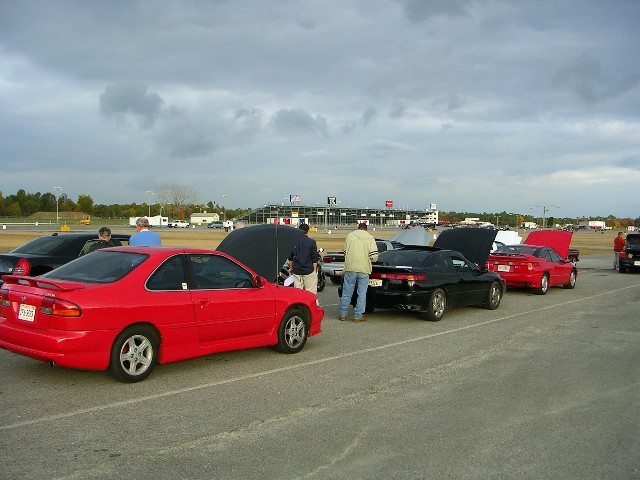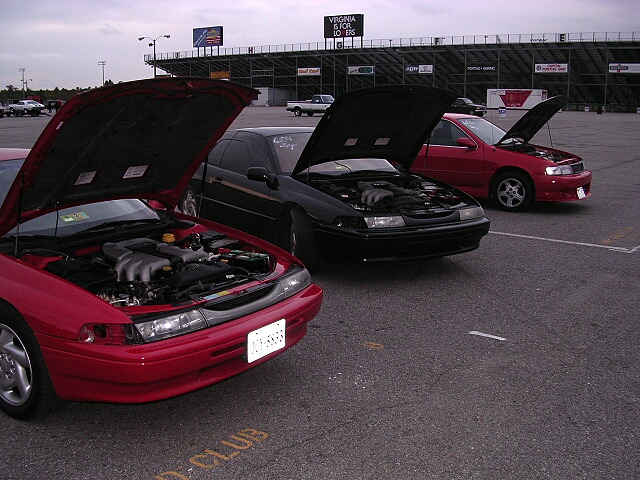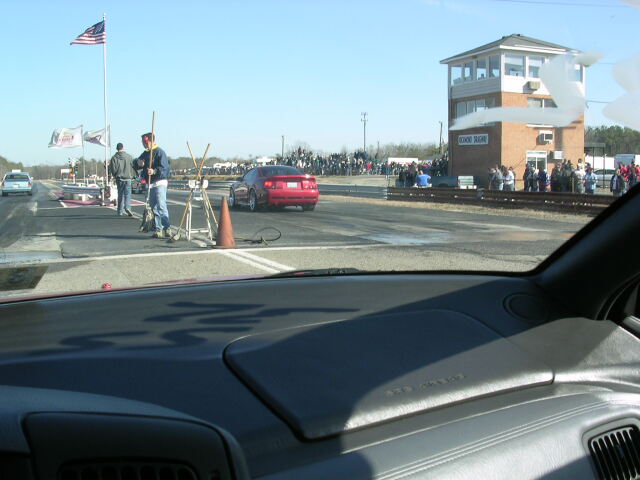Drag Racing Your SVX
Author: Chiketkd & Svxfiles
The following write-up is a helpful guide to use when taking your SVX to the drag strip.
Preparation – The SVX, like any other sports car, performs best when it’s well maintained. Therefore, only consider drag racing your SVX when all maintenance is up-to-date. If your car has a slipping transmission, a damaged cv joint, or is in need of a major tune-up, racing your SVX at the drag strip will only increase the risk of doing serious damage to your car. Fix these problems first.
Before leaving home, remove any unnecessary weight from your car – stereo equipment, cd cases, books, tool boxes, etc. Depending on how far away you live from the track, you may also want to leave your spare tire and jack at home as these two items alone weigh close to 40lbs. To keep weight down even more, aim to race your SVX with a 1/4 tank or less of gas in your car. It is also a good idea to check your tire pressures and make sure their set to the factory settings. Never attempt to race your SVX unless you’re using 91 grade premium unleaded fuel!
Arriving at the Drag Strip – It’s always best to arrive early at the drag strip, especially if it’s your first time going. This will allow you to get familiar with the surroundings. Find out from the admission attendant where the ‘Tech Inspection’ area is and head immediately over there.
Passing Tech – Once arriving at tech, get in line and turn off your engine to let it cool down. At the gate you would have been handed a tech card which will ask you for some specific information about your car. Start filling it out as the tech inspector will ask for it when they come to look over your car. The tech inspector will give your car a quick once over to make sure the battery is properly fastened down and your seat belts are in working order. Once the tech inspection is done, the inspector will write your racing number and class on the front windshield and one side window most commonly with white shoe polish.

The Pits – This is the area where racers will wait after passing tech (or between races) for their racing class to be called. Drive over to the pits and once you’ve found a good location, turn off your engine and pop your hood to allow your engine to cool down even more quickly. If you drove with your spare tire and jack in the trunk, the pits would be the area to remove it and find a safe place to store it while you race.

Staging Lanes – When the announcer calls your class, close your hood and drive over to the staging lanes and line-up in the lanes assigned to your class. You will typically still have another 20-30 minute wait before racing, so turn your engine off until it’s your lane’s time to race.
The Burnout/Water Box – When it’s your turn to race, you will drive out of the staging lanes with your opponent, and see a device known as a ‘staging tree’ as well as the starter ahead of you. Before getting to them, there will be a small 1-2ft wide area lightly covered in water. This is the burnout or water box and it is used by rear-wheel and front-wheel drive cars to heat up their tires and make them stickier before racing. Only if you have a fwd SVX should you attempt to do a burnout. Doing a burnout on an awd SVX can cause serious damage to the drive train. If you're not plnning to do a burnout, drive around the water box.

At the Staging Tree – The staging tree consists of two columns of lights (one for each drag racer) and 7 rows of lights coming down each side. As you drive slowly up to the starting line, the top pair of yellow lights will come on to let you know that your front tires are at a point just a few inches away from the starting line. You are now pre-staged for racing. Out of courtesy, wait for your opponent to pre-stage before moving forward any further.
Once each racer is pre-staged, inch forward a little more and the second pair of yellow lights will come on. This means you are deep-staged and at the starting line. When your opponent has deep-staged as well, there will be a brief pause before the other lights come on.
The three amber lights directly below the pair of deep-stage lights will come on one after the other in 1/2 second intervals. After the third amber light has come on, the green light will come on a 1/2 second later indicating that it’s time to go. If you leave the starting line too early, the bottom red light will come on indicating an illegal early start.
The Launch – When the green light comes on, your launch off the starting line plays a huge part on the final time at the end of the 1/4 mile. Your launching technique will vary depending on whether you have a fwd or awd SVX.
FWD Launch: As only the front wheels are driven, it’s much easier to break traction and spin your tires if you mash the gas pedal off the line. As the amber lights come down the tree, keep your left foot on the brake pedal and slowly press the gas pedal with your right foot and bring the revs up to 1500-1800 rpms. This is known as power-blocking the engine and is actually better for your car than mashing the gas pedal from idle, as any ‘slack’ in the driveline is taken up. When the light goes green, press the gas pedal down about half way at first until your front tires gain full traction and hook up with the track. Once that happens, put the gas pedal to the floor for the rest of the way! You should be able to do high 2.2 to low 2.3 second 60ft times with this method once perfected.
AWD Launch: As all four wheels are driven, it’s much harder to break traction coming off of the starting line. When the amber lights come down, power-block your engine up to 2,000-2,200 rpms (to take up drive-line slack) and put the gas pedal to the floor when the light goes green – you may notice a brief scuffing of all four tires, but they will quickly regain traction and shoot you out of the whole. For even faster starts, you can power-block your car all the way up to the stall speed of the torque converter which is around 2500rpms - don’t do this for more than a few seconds as it generates heat in your transmission. A properly executed awd launch in an SVX will result in a low to mid 2.2 second 60ft time.
The 1/4 mile – As the SVX is an automatic car, leave the shifter in ‘3’ or ‘D’ and press the gas pedal to the floor for the entire run. If you do not know where the finish line is, drive through the point where the score board is that displays the time after each race. Then back off the gas, hit the brakes, look around for your opponent, and make your way safely back to the pits. On the access road back to the pits there will be an attendant, typically in a small booth, who will hand you a copy of the time slip for your race. Keep this for bragging rights later!
The Reality of it all – The SVX is a hefty grand touring sports coupe that wasn’t designed for 1/4 mile racing. The typical awd SVX weighs in at 3500-3600lbs (depending on trim level), while fwd versions weigh around 3300-3350lbs. The wide-ratio 4 speed automatic transmission and tall 3.545 (found in US awd SVXs) or 3.70 (found in US fwd and UK, JDM or Aussie awd SVXs) gearing doesn’t help matters either. The powerful and wonderfully torquey EG33 engine does help a great deal, but a relatively stock SVX will do a 1/4 mile somewhere between 15.5 – 16.5 seconds. Installing a 5 or 6 speed manual or switching to an automatic Subaru transmission with shorter gearing (3.90, 4.11 or 4.44) will help lower times even more considerably.